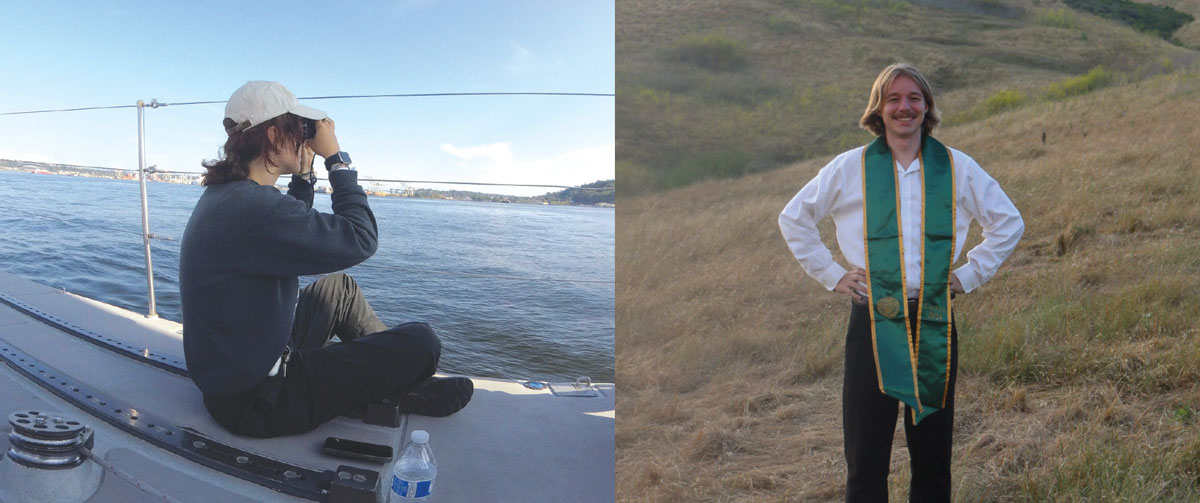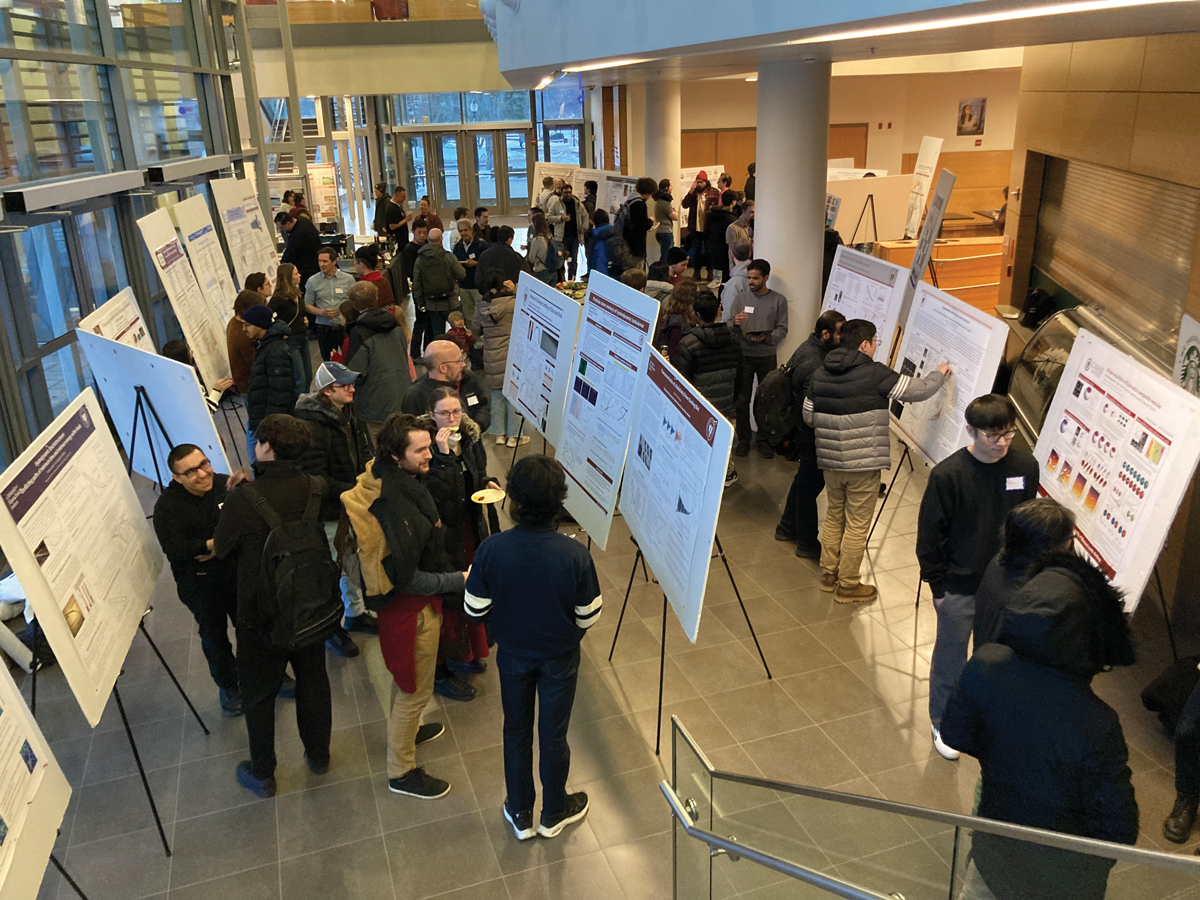Funding uncertainties muddle graduate admissions
DOI: 10.1063/pt.dtvw.eltg

Sara Earnest (left) and Hudson Lazzara (right) are among the physics PhD applicants who got caught up in a chaotic, confusing admissions process this year. (Photos by Otis Michael Jr and Chase Hayes, respectively.)

“Strange and harrowing.” That’s how Sara Earnest describes the process of applying for physics PhD programs this year. She graduated in May from Johns Hopkins University with two and a half years of undergraduate research experience. But just two weeks shy of the 15 April national deadline for prospective students to commit to graduate programs, she had been wait-listed by one, rejected by seven, and was still waiting to hear from three.
In the end, Earnest didn’t get into any of them. She plans to try again next year. In the meantime, she’s headed to Chile for a research stint studying black holes.
Hudson Lazzara didn’t get into any of the five physics graduate programs he applied to his first go-round; he graduated in 2024 from California Polytechnic State University. This year, he applied to 13 programs at 9 schools and got into 2: complex systems at Arizona State University and physics at the University of Oregon.
But “getting in” turned out to be a slippery concept. He visited Arizona State in early April and was told he would get a one-year fellowship, but by the end of the month, the paperwork hadn’t come through. Oregon accepted him in January, but instead of following up with a formal offer, the university wait-listed him. On 17 April, he got the news that he was in with five years of guaranteed support. He starts there this fall.
Earnest’s and Lazzara’s experiences reflect both a long-term trend of growing competition to get into US physics PhD programs and the disruptions to higher education since the start of the current Trump administration, in particular the prospect of severe reductions in funding. (See “Rapid-fire changes in federal funding stoke uncertainty in US universities
In April, the chairs of US physics and astronomy programs expected to accept 13% fewer PhD students—about 600—for fall 2025 than in the previous year, according to a survey conducted by the American Institute of Physics’ statistics team (see Physics Today, June 2025, page 23
For many graduate schools, the admissions process this year was fraught: Would applicants be more likely to accept offers knowing that other schools were reducing the sizes of their incoming classes? Would departments be able to keep their commitments to incoming students? Would they be able to continue supporting their senior graduate students?
Reactions to unknowns
In the fall and winter, physics graduate admissions committees typically poll their faculty members to see how many want to take new PhD students and how many expect to be able to support them on external grants. The committees also look at their institution’s need for teaching assistants (TAs)—it’s common for physics PhD students to work as TAs for their first year or two and thereafter as research assistants (RAs) on their adviser’s grants. Many admissions committees try to align their offers such that prospective students’ research interests roughly match those of the groups looking to expand. Then they make their best guess as to how many offers to make to end up with their target class size.
This year, however, historical norms for making those guesses were out the window. Some departments reduced the number of offers that they made but still got large numbers of acceptances; others introduced wait-lists, tiered offers, or other measures to try to control their final numbers.
Last year’s incoming class of 75 physics PhD students at the University of Illinois Urbana-Champaign was unusually large, so the department was aiming to scale back to its usual 45–50 students even before the presidential elections, says Lance Cooper, associate head for graduate programs in physics. “We reduced the number of offers by about one-third,” he says. “We nervously watched as the numbers rolled in. In spite of our best efforts, we got 78 accepts.”
“We went back and forth about what our strategy would be,” says Steven Rolston, chair of physics at the University of Maryland (UMD) in College Park. “We made fewer offers, and, for the first time, they were tiered.” The strongest applicants received the department’s standard offer of two years of guaranteed support as a TA, he says. A second set of applicants was offered one year of guaranteed TA support, and a third tier was accepted on the condition that they find a faculty member who would hire them as an RA from the get-go. UMD physics gets 1000 applications for 45 or so spots, says Rolston. This year, they ended up with 36 students.

Prospective graduate students visit the University of Massachusetts Amherst in February. (Photo courtesy of Scott Hertel.)

The physics department at the University of Iowa took a different tack. “We accepted people but waited to send out employment offers,” says physics and astronomy chair Mary Hall Reno. “We were working on the basis of what’s in hand, not on the basis of what is likely to be funded because we just don’t know anymore.” In the end, she says, 10 students will start in the fall, 8 as TAs, 1 as an RA, and 1 with a fellowship. With fewer graduate students than usual available to serve as TAs, she adds, “we will have to squeeze more undergraduates into lab sections.”
By the time the physics department at the University of Oregon began making offers, the university administration was gun-shy: The chemistry department had so many students wanting to come that it ended up rescinding offers to applicants who had not yet accepted, says physics chair Richard Taylor. The experience prompted the university administration to insist that the physics department “drill down” to figure out how many students it could support. That included estimates about when senior graduate students would complete their degrees and internal pressures related to tuition dollars—resulting in the university allotting fewer teaching assistantships. It also took into account pessimism about federal funding.
“We came down to six,” Taylor says. The department’s incoming class usually numbers around 18. “The good news is the university allowed us to offer guaranteed support for five years.” To limit to six incoming PhD students, the department introduced a waiting list—the one that Lazzara had been on—and made offers as space allowed. Taylor says he expects to use wait-listing going forward.
Compounded implications
Other departments similarly staggered their offers, made fewer of them and offered less, conditioned them on student performance and availability of funds, and held their breath. For many departments, the warning signs came too late in the admissions cycle to respond. “We didn’t do anything out of the ordinary,” says Dan Hooper, a member of the graduate admissions committee at the University of Wisconsin–Madison. “But if next year it’s clear we don’t have money to sustain students, we would have no choice but to admit fewer students.”
Faculty members also worry about senior graduate students, who often do not have guaranteed funding but traditionally have been covered by research grants. Historically, if an advanced graduate student lost their research assistantship, they could often fall back on a teaching assistantship. But institutions would not be able to step in like that for large numbers of students. “We have told our faculty that they should encourage their students to graduate faster,” says UMD’s Rolston.
On top of worries about funding are concerns about the US government’s policies toward foreigners. In physics, international students have long made up a huge chunk of the graduate body. So far, at least, they still want to come to the US: At the University of Illinois Urbana-Champaign, for example, where the domestic-to-international ratio is usually about 50:50, for the 2025 incoming class, it’s 44:56. But recent developments, including US government threats to revoke visas of Chinese students, a pause on conducting interviews for student visas, and the spate of detainments of people from multiple countries, could make it harder for some to get into the US and make the country a less desirable destination. On the flip side, some US professors are advising their graduating seniors to apply for PhD spots abroad.
In the long term, shrinking graduate enrollment would damage both individual departments and the broader physics community. “Every step along this trajectory will be harder to advance, and there will be far fewer opportunities for talented young researchers to make a career,” says Hooper. “The US science system is the envy of the world, and we should think twice before we decide to tear it down.”
This article was originally published online on 6 June 2025.
More about the Authors
Toni Feder. tfeder@aip.org

